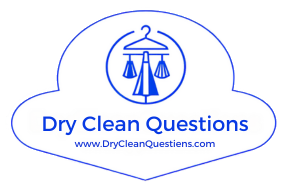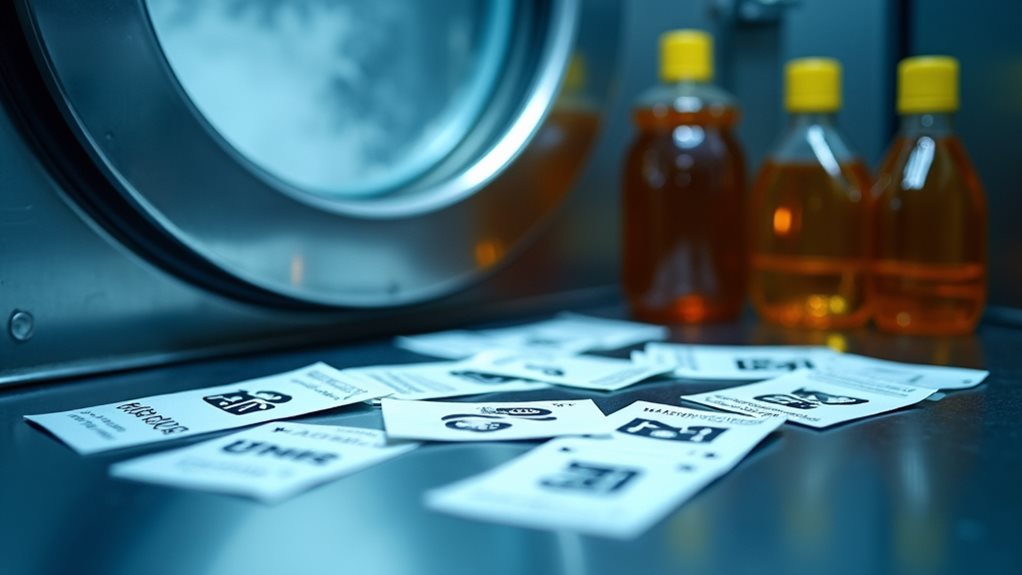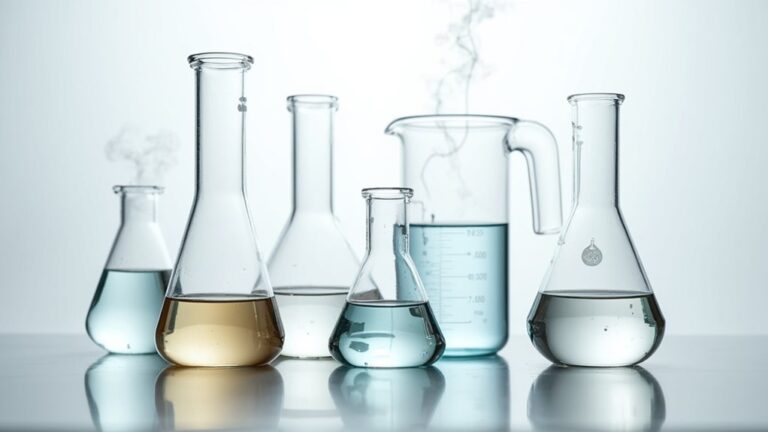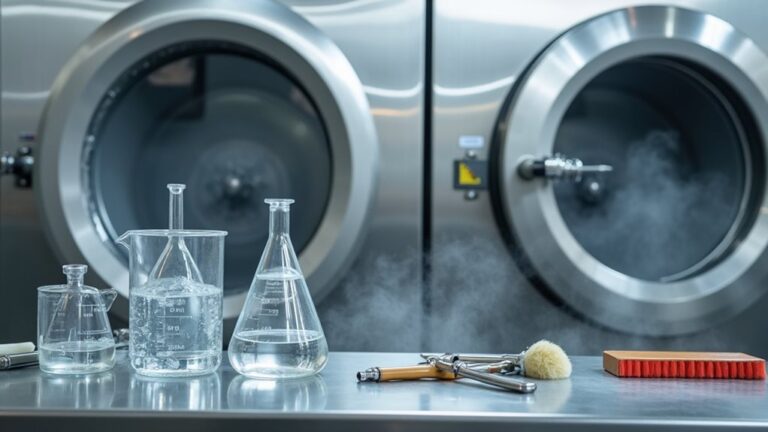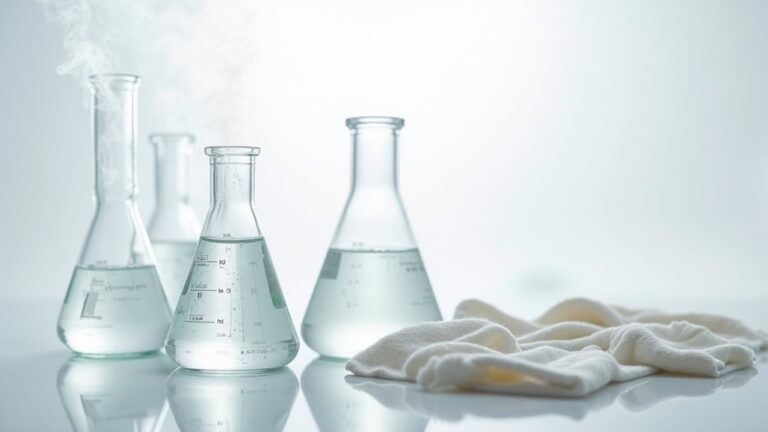Yes, traditional dry cleaning can be harmful to your health and the environment. The primary culprit is perchloroethylene (PERC), a toxic solvent classified as a human carcinogen that can cause dizziness, headaches, and is linked to bladder cancer. This chemical lingers on your clothes after cleaning, releasing vapors into your home’s air, while also contaminating groundwater and disrupting local ecosystems when improperly disposed of—though safer alternatives like liquid CO2 and wet cleaning methods offer hope for conscious consumers.
The Toxic Chemicals Behind Traditional Dry Cleaning
When I first learned about the chemicals lurking in traditional dry cleaning, I felt like I’d discovered a secret that nobody talks about, even though it affects millions of us who rely on professional cleaning for our work clothes and delicate fabrics.
The hidden truth about dry cleaning chemicals feels like an industry secret affecting millions who trust professionals with their delicate garments.
The main culprit is perchloroethylene (PERC), a toxic chemical that’s literally classified as a human carcinogen. This stuff doesn’t mess around – it causes acute health issues like dizziness and headaches, while long-term exposure creates serious cancer risks, particularly bladder cancer and non-Hodgkin lymphoma.
What really gets me is how dry cleaning workers face daily exposure to environmental pollution from these chemicals.
One of the biggest concerns is that PERC residues can remain on your clothes even after the cleaning process is complete, especially when garments aren’t given enough time to properly air out.
Thankfully, alternatives to PERC are emerging, though they come with their own health risks we need to understand.
Health Risks for Workers and Consumers
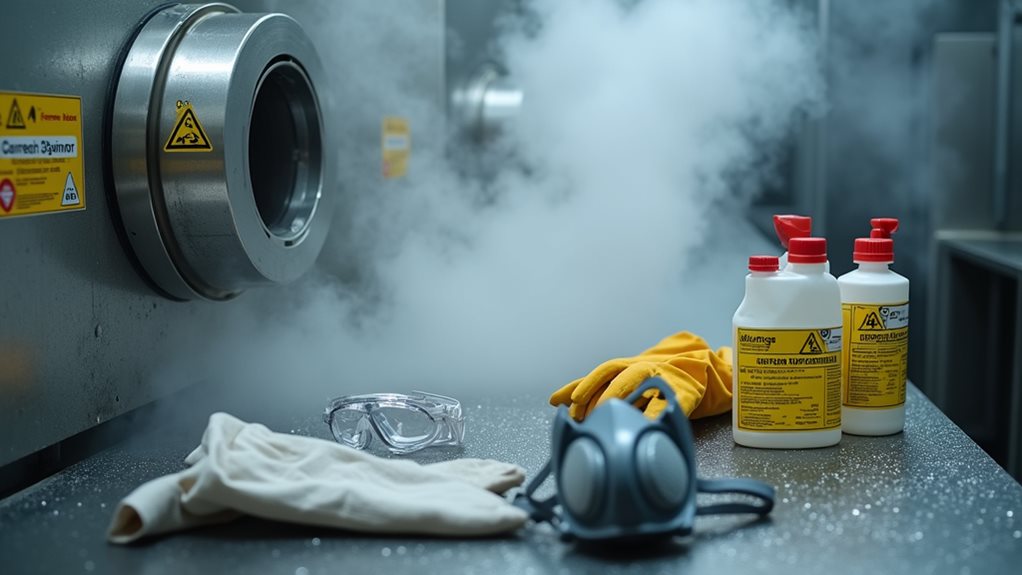
While the environmental concerns around dry cleaning are troubling enough, the human health toll hits much closer to home, especially when you consider that real people – the workers handling these chemicals daily and consumers like you bringing freshly cleaned clothes into their bedrooms – face genuine risks that most of us never think about.
Dry cleaning workers endure the worst exposure, breathing PERC and other carcinogens for hours each day, leading to dizziness, headaches, and long-term risks like bladder cancer and liver damage from chronic exposure.
You’re not off the hook either – residual chemicals cling to your freshly cleaned garments, releasing vapors into your home’s air. The Georgetown study showed PERC levels actually increase with multiple cleanings, yet federal regulations remain virtually nonexistent. 😬
To minimize exposure risks, experts recommend allowing cleaned garments to air out before wearing and choosing facilities that use safer alternatives like liquid CO2 cleaning or wet cleaning methods.
Environmental Impact of Dry Cleaning Solvents
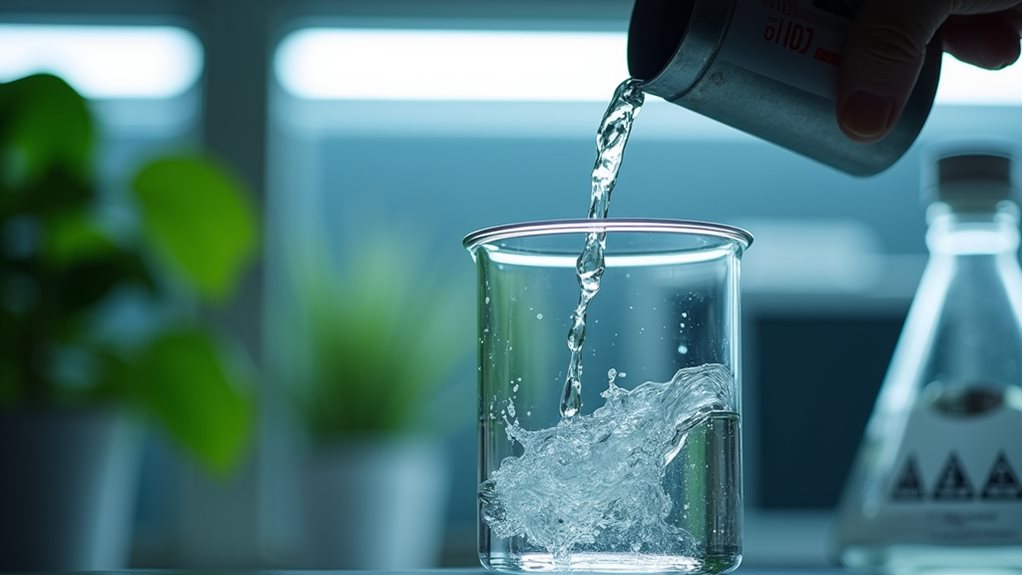
When you drop off your favorite dress at the dry cleaner, you’re probably not thinking about where those chemical vapors end up, but the truth is they don’t just disappear into thin air like magic 🪄.
Those harsh solvents, especially perchloroethylene, can linger in outdoor air for weeks after escaping ventilation systems, and they’re notorious for contaminating groundwater when facilities aren’t careful with disposal.
What’s particularly heartbreaking is watching how these chemicals don’t just harm our breathing space, but they also threaten the delicate balance of local ecosystems, from the soil beneath our feet to the waterways that sustain wildlife.
Fortunately, many facilities are now transitioning to safer alternatives like wet cleaning, liquid CO2, and hydrocarbon solvents that significantly reduce environmental impact.
Air and Water Pollution
Although most of us don’t think twice about dropping off our favorite blazer at the local dry cleaner, the environmental consequences of this seemingly innocent errand ripple far beyond the storefront’s doors.
You’re unknowingly contributing to air and water pollution through perchloroethylene, the industry’s go-to solvent that escapes into our atmosphere and lingers for weeks. These toxic chemicals don’t just vanish—they accelerate ozone depletion while seeping into soil and groundwater contamination that threatens drinking water sources.
When you bring freshly cleaned clothes home, residual chemicals vaporize indoors, creating indoor air pollution and health risks for your family.
Even alternative solvents like n-propyl bromide present similar environmental issues, proving this industry’s struggle with sustainable practices affects ecosystems far beyond your closet.
The EPA and International Agency for Research on Cancer have classified perchloroethylene as a probable human carcinogen, raising serious concerns about the long-term health implications of repeated exposure.
Ecosystem Damage Risks
The true environmental tragedy unfolds when we examine how dry cleaning services systematically dismantle the delicate web of life that sustains our planet’s ecosystems.
When you think about environmental degradation, you’re witnessing a slow-motion disaster that’s honestly heartbreaking to observe.
These toxic substances, particularly perc, don’t just vanish after cleaning your favorite blazer—they persist for weeks, infiltrating every corner of our natural world.
Ground contamination spreads like an unwelcome houseguest who overstays their welcome, poisoning soil and stunting plant growth for years.
Water systems become silent victims, threatening marine life and our drinking supplies alike.
The ecosystem damage from chemical solvents creates ripple effects that’ll make you reconsider that “dry clean only” label. 🌍
The improper disposal of contaminated materials from dry cleaning facilities further amplifies these environmental risks by introducing persistent toxins directly into soil and water systems.
Chemical Residue That Stays on Your Clothes
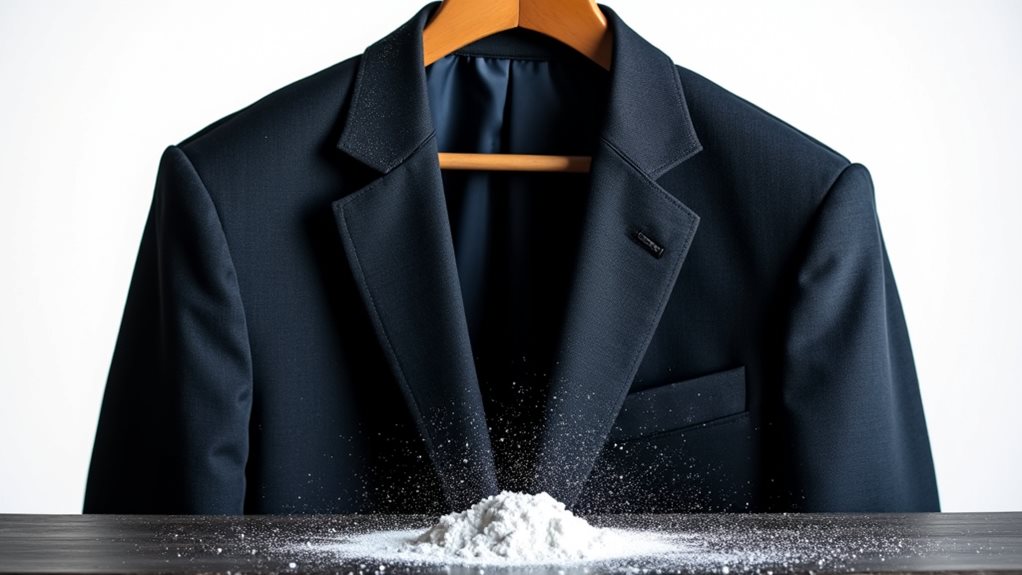
When you pick up your freshly dry-cleaned clothes, you’re not only getting back fabric that’s been cleaned—you’re also getting a chemical hitchhiker called PERC that stubbornly clings to different materials in ways that might surprise you.
I learned this the hard way when I discovered that my favorite wool blazer was basically a walking chemistry experiment, because fabrics like wool, cotton, and polyester hold onto these solvents much more than silk does, and each trip to the cleaner actually makes the problem worse.
The real kicker is that this invisible residue doesn’t just sit there quietly—it slowly vaporizes into your home’s air every time you wear or hang up those clothes, turning your closet into an unintentional science lab that you definitely didn’t sign up for.
To minimize exposure, always let your dry-cleaned items air out in a well-ventilated area before bringing them into your living space, as this simple step can significantly reduce the amount of chemical residue that ends up contaminating your indoor air.
Perc Builds Up
Once you hang that freshly dry-cleaned blazer in your closet, you might assume the cleaning process is complete, but here’s what most people don’t realize: perc doesn’t just disappear after the cleaning cycle ends.
This vaporizable chemical actually builds up in your fabrics over time, creating an invisible threat that follows you home. Each trip to the dry cleaner increases residual levels, particularly in wool, cotton, and polyester garments, while your stored dry cleaned clothes quietly release perc into your indoor air.
I learned this the hard way when my favorite suit developed that persistent chemical smell 😅. The accumulation creates ongoing health risks through inhalation exposure, turning your wardrobe into an unintended source of contamination that affects your living space.
This is why consumers should always properly air out their freshly cleaned garments before wearing them, as chemical residues remaining on clothes can lead to direct exposure through both inhalation and skin contact.
Fabric Type Matters
While all fabrics absorb perc during dry cleaning, your clothing material determines just how much chemical residue you’ll be carrying around, and frankly, some fabrics are like chemical sponges that refuse to let go.
Wool’s particularly notorious for this, clinging to perchloroethylene like it’s going out of style, while cotton and polyester aren’t much better at releasing these stubborn chemical residues.
Here’s what really gets me: silk seems to dodge this bullet entirely, barely retaining any chemicals at all.
When you’re dealing with repeated dry cleaning cycles, you’re fundamentally building up layers of consumer exposure that contribute to indoor air pollution every time you open your closet.
Different fabric types create wildly different levels of chemical exposure, making your wardrobe choices surprisingly significant for your health.
The International Agency for Research on Cancer has classified PERC as a probable human carcinogen, linking occupational exposure to increased risks of bladder, esophageal, and cervical cancers.
Vaporization Health Risks
Because those chemical residues don’t just sit there politely on your clothes like invisible houseguests, they actually vaporize into the air around you, turning your freshly cleaned wardrobe into a slow-release toxic cloud that you’ll be breathing for days or even weeks.
The vaporization of PERC creates serious health risks, especially when you’re spending hours in your bedroom or closet surrounded by recently dry-cleaned garments. You might notice respiratory issues, persistent headaches, or that weird chemical smell that seems to follow you around—that’s your indoor air quality taking a hit from toxic fumes.
Georgetown University’s research shows these chemical residues stick around stubbornly, which is why many experts are pushing for safer alternatives to protect your home environment. Health agencies have classified perchloroethylene as a probable human carcinogen, making the vaporization of these residues an even more concerning health issue.
Safer Alternatives to Conventional Dry Cleaning

As someone who’s watched the dry cleaning industry evolve over the past decade, I can tell you that safer alternatives to conventional perchloroethylene cleaning have become not just available, but genuinely accessible to everyday consumers like you and me.
You’ll find eco-friendly methods using liquid silicone (D5), which won’t leave you worried about health risks while still getting your clothes spotless.
I’ve personally tried liquid carbon dioxide cleaning – it’s surprisingly effective and environmentally safer than traditional methods.
Professional wet cleaning has also impressed me with its gentle approach to delicate fabrics.
Many local cleaners now offer organic dry cleaning services with convenient delivery options, making it easier than ever to avoid perchloroethylene’s harmful effects while keeping your wardrobe fresh.
For regular garment maintenance at home, steam cleaning offers an excellent chemical-free option that uses high-temperature water vapor to effectively remove dirt and odors from your clothes.
How to Choose Eco-Friendly Cleaning Options

Finding the right eco-friendly dry cleaner feels a bit like dating – you’ll need to ask the right questions upfront to avoid disappointment later 😊.
Start by inquiring about which solvents dry cleaners use, prioritizing those offering liquid carbon dioxide or wet cleaning methods over traditional dry cleaning chemicals like PERC. These safer alternatives dramatically reduce your chemical exposure while delivering excellent results.
Ask about solvents upfront – choose liquid carbon dioxide or wet cleaning over PERC for safer, effective results with minimal chemical exposure.
Look for eco-friendly dry cleaners utilizing liquid silicone (D5), which cleans effectively without harmful residues.
Don’t forget practical considerations – many environmental friendly cleaners offer convenient delivery services or mail-order options.
Research reviews of local organic cleaners online, and use zip code tools to compare costs.
